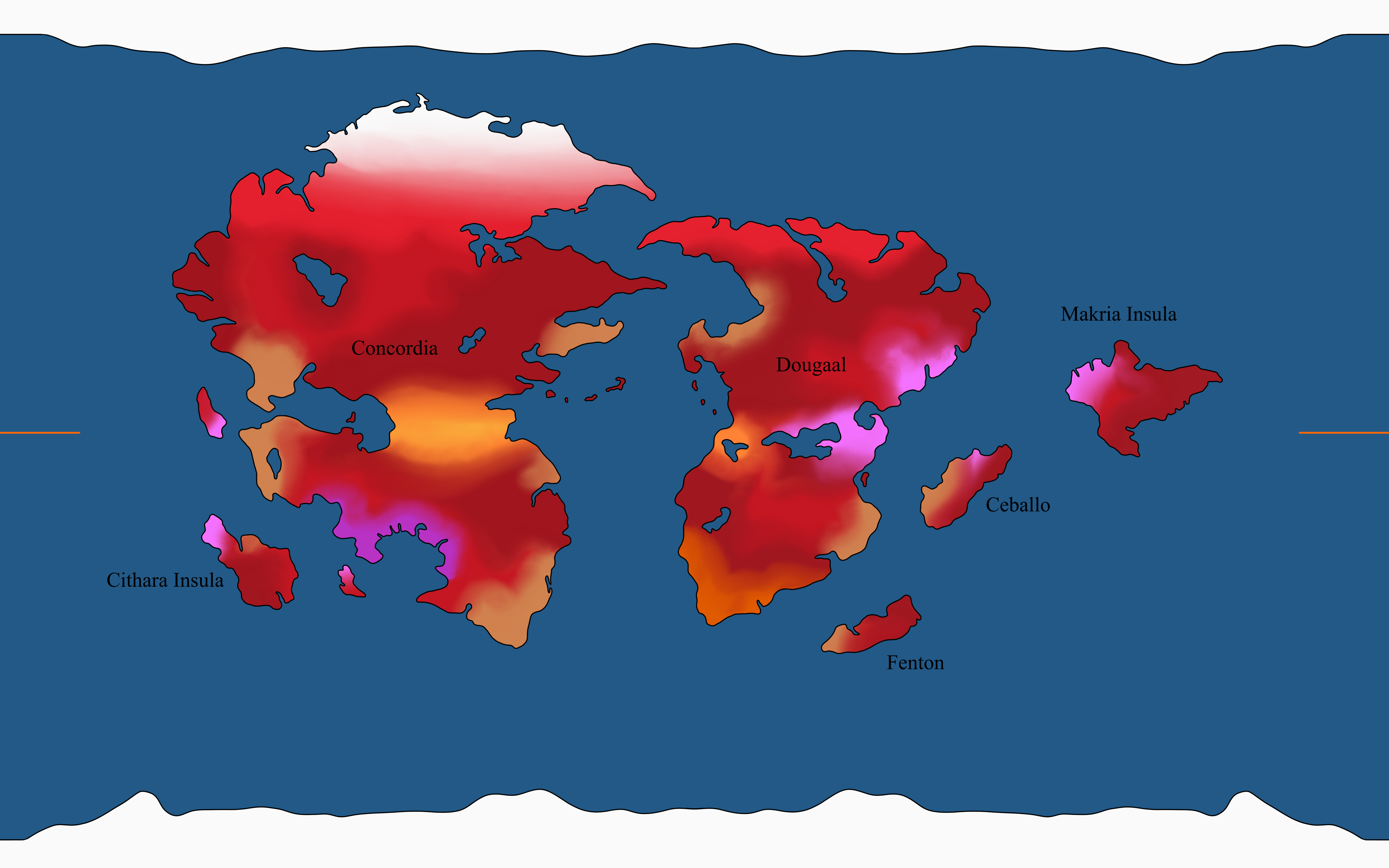HOME | DD
 Sorroxus — Endos Map
Sorroxus — Endos Map

#map #planet #world #worldbuilding #specbio #specevo
Published: 2024-03-25 17:21:00 +0000 UTC; Views: 1665; Favourites: 17; Downloads: 2
Redirect to original
Description
Red - Steppe
Dark Red - Forest
Light Red - Tundra
White - Snow/Arctic
Orange - Savanna
Dark Orange - Rainforest
Yellow - Arid Land
Pink - Jelly-tree Forest
Purple - Jelly Steppe
Brown - Clambush Forest
Steppe:
The steppe is a common biome on Endos, and is home to many steppe-adapted species, including carnivores and herbivores. The dominant plant life in the steppe is the lampaphytes, which are akin to grass on Earth. In addition, there are small groves of trees scattered about, which provide shade under the sun and some shelter during rain storms. Animals in the steppe are mostly either light and athletic or large and ponderous. Some animals rely on speed to escape predators, while others rely on size to deter predators.
Forest:
Endonese forests are full of trees, just like Earth forests. The forests cover a lot of the planet, and host a relatively diverse ecology. There are a lot more little animals in the woods than on the steppe, and there are also some pretty large animals roaming around, as well.
Tundra:
The tundra is a cold, barren biome with little biodiversity, and those who inhabit the tundra are often large and solitary. Tundra-adapted lampaphytes serve as a food source for herbivores. Creatures adapted for tundra life are often stocky and bulky, having both a thick layer of fat and possessing fur. Stithopods with fur are quite rare, and really only exist in colder regions of the world, like the tundra. Because the tundra is so barren, there is little biodiversity.
Arctic:
There isn’t much to say here, other than only the hardiest of animals can survive in these cold, unforgiving conditions. Animals that live in the arctic region tend to have blubber and fur. Similar to the tundra, there is little biodiversity in the arctic region of Endos.
Savanna:
The savanna is a dry biome, with large swathes of grassland, bush, and trees. On Concordia, the savanna splits the continent in half, and many call the savanna the “Concordian Belt.” Small animals in the savanna often burrow under the ground to both hide and keep cool. The savanna is a hot place, and larger species have evolved dewlaps or crests to help keep cool.
Rainforest:
Located in southern Dougaal, the rainforest has the highest biodiversity of any biome. It is thick and hard to navigate, and the density of the trees reduces light level at ground-level. Many animals live in the trees, while others live on the ground, eating vegetation, while others eat meat.
Arid Land:
The Arid Land is a hot, barren landscape with little biodiversity and little water. Many Stithopods in the Arid Land tend to be on the smaller side, and many have evolved to dig burrows and holes to keep them cool under the baking sun. Others have evolved dewlaps or crests, as well, much like those in the savanna. Animals here also have adaptations that help them go weeks without water, as well as adaptations that help them trek long stretches of barren desert in their search for food. The biome itself is akin to the Mojave Desert of Earth.
Jelly-tree Forest:
The Jelly-tree Forest is one of the three unique biomes Endos has to offer. The Jelly-tree forests are characterized by the presence of Jelly-trees, tree-like flora with squishy, gelatinous insides. Many Stithopods living in the Jelly-tree Forests have evolved to feed on the gelatinous insides, with some evolving saw-like beaks to cut open the leathery skin of the Jelly-trees to get to the insides. Jelly-trees themselves are thought to have originated on Dougaal, and later spread out to the other islands, but never Concordia for some reason. We’re not sure why, but one day, we will know.
Jelly Steppe:
The Jelly Steppe is the second unique biome of Endos, and the Jelly Steppe can be considered a living biome. The mass of purple jelly-like substance is actually compacted amoebas, and because they keep multiplying at a steady rate, the Jelly Steppe has been around for a very long time, and is home to a few odd creatures, some of which feed on the Jelly Steppe itself, which limits the Jelly Steppe’s size, while others dig out and eat slithering worm-like creatures that burrow in the Jelly Steppe’s gelatinous flesh. Animals here tend to have border hooves, with the foremost pair of hooves being considerably broader than the other pairs. This helps with balance, and, in larger varieties, allows them to spread their weight over a larger area to prevent from sinking. Sinking doesn’t occur too often, but it can happen.
Clambush Forest:
The Clambush Forest is the third unique biome of Endos, and is comprised of odd creatures known as “Clambushes.” A Clambush is a large type of polypod that has planted itself in one spot, destined to stay there for the rest of its life. The Clambush has a tough shell and spines on its neck to help keep it safe, but some Stithopods have evolved to break open the shells and get to the meaty insides. Clambuses are also a rare example of a “planimal” on Endos, as the Clambushes, while animals, gain their energy from photosynthesis. Clambush Forests, unlike the Jelly Steppe or the Jelly-tree Forests, are found on both the continents, as well as the islands.
Related content
Comments: 6

👍: 1 ⏩: 1

👍: 1 ⏩: 0

👍: 1 ⏩: 1

👍: 0 ⏩: 1

👍: 1 ⏩: 1

👍: 0 ⏩: 0

























